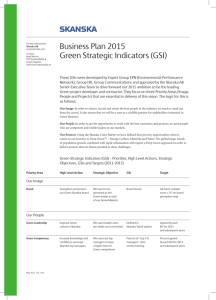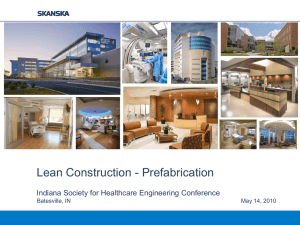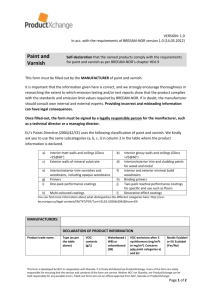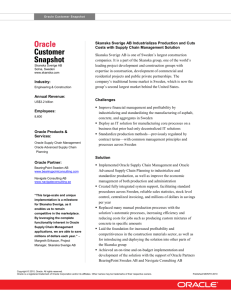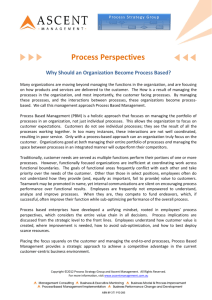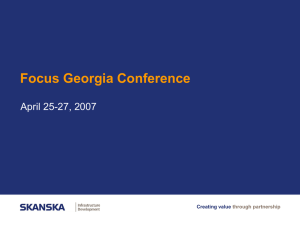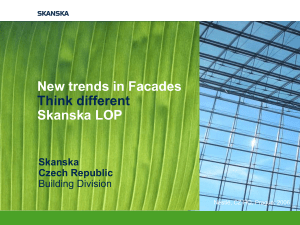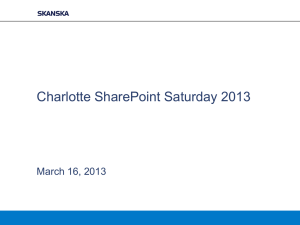BPO Standard
advertisement
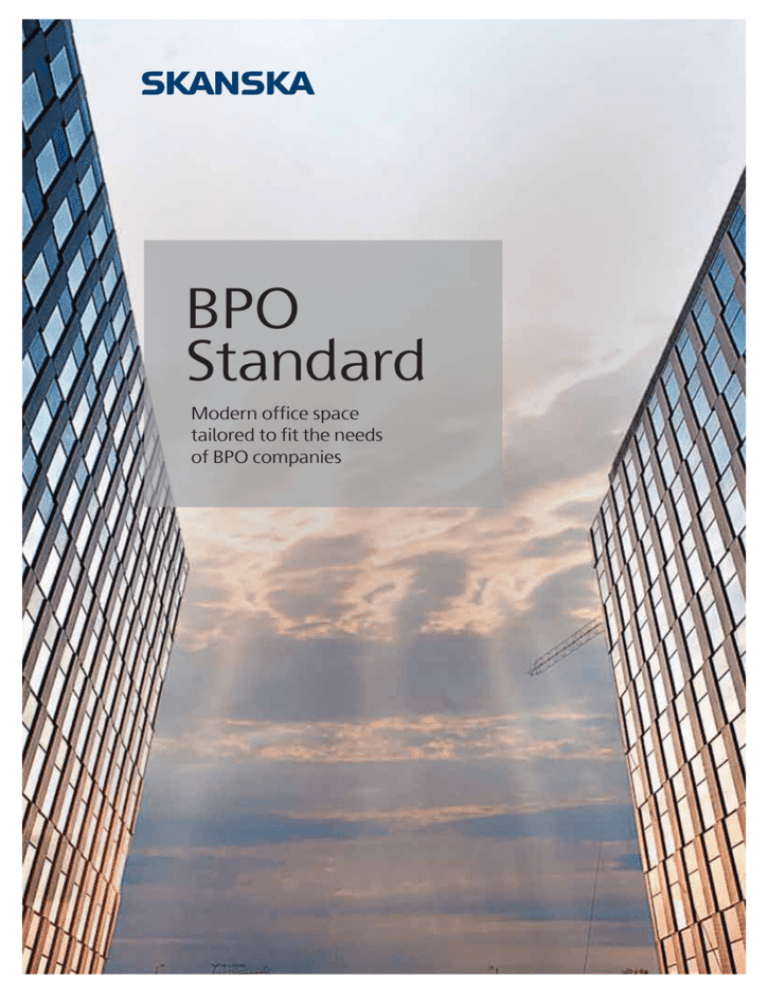
BPO Standard Modern office space tailored to fit the needs of BPO companies 01 Introduction Modern organisations offer services that can be classified in a number of ways. As far as outsourcing is concerned, there is offshoring and nearshoring as well as business process outsourcing, knowledge process outsourcing and shared service centre. Central-Eastern Europe (CEE), and in particular, countries associated with the European Union, such as Poland, Czech Republic, Slovakia, Hungary, Romania, and Bulgaria, have recently proved to be an important location on the global map of modern business centres. Poland has won the leading position in terms of employment rates in the sector. According to recent estimates, in the period of 2008 – 2011, an average annual increase in employment rate reached roughly 20%. Additionally, by the end of 2012, the industry will employ approx. 100,000 people in foreign capital companies. Skanska is an innovative developer of office space which, thanks to its flexibility and versatility, can correspond with the needs of companies from a variety of market and business sectors. All of our projects are implemented according to the standards set out by the U.S. Green Building Council. This institution grants the LEED environmental certificates which reconfirm the quality of our investments. This document is to demonstrate how Skanska’s buildings meet the requirements of clients from the BPO (Business Process Outsourcing) sector. The requirements were identified based on a report “BPO/SSC: the sector speaks on optimal office solutions to suit business needs in Poland”, that Skanska put together in cooperation with Jones Lang LaSalle (JLL) as well as Association of Business Service Leaders in Poland (ABSL). We would like to thank the ABSL organisation and Krystian Bestry – Managing Director of Infosys BPO Europe. Without their experience and will to share their knowledge of the rapidly developing sector of modern business services, it would not have been possible to prepare this document. 2 Poland has seen a dynamic development in the sector of BPO and SSC in the recent years. At the end of 2011, the sector employed 85,000 people. Moreover, it is expected that this year the number will exceed the threshold of 100,000 . About 40% of shares in the business outsourcing market within CEE belongs to Poland. It is considered that the Polish market has entered the maturity phase. This is shown by the presence of such organisations like ABSL or Insytut Outsourcingu that unite and represent the interests of outsourcing companies. Offshoring stands for the relocation of certain business functions or specific parts of an organisation outside of its headquarters, primarily in order to reduce operational costs or gain relevant human resources. Offshoring can be managed internally by a company or outsourced to an external provider. Nearshoring means the transfer of business to a nearby country, often sharing a border with the company’s native country, so as to benefit from cultural and geographical proximity. Hence the CEE region is home to many major service centres of companies from Western Europe or the US. Outsourcing sectors: BPO (Business Process Outsourcing) describes contracting of selected business functions and processes to a third-party provider. SSC (Shared Service Centre) stands for contracting of selected business functions and processes to a part of an organization (internal service provider). KPO (Knowledge Process Outsourcing) involves contracting of selected business functions and processes related to analyses and expert’s reports to an external provider, including R&D centres. 3 02 Skanska responds to tenants’ needs 03 Expectations of the tenants We have our clients in mind from the very early stages of implementing a project. We are committed to responding to their needs and delivering the best possible product in the form of office space. We take a unique approach to business relationships. The dedicated team leads the client throughout all stages of office space development. This enables us to get to know individual expectations, monitor the market demand, and collaborate accordingly to implement the ideas. What are the elements that you are most interested in when deciding on a site for your new office? 2 2,5 3 3,5 4 4,5 5 Access to public transport Cost of rent Location We know what modern organisations value the most. Those aspects are also most important to us when planning a project. Our buildings are bespoke to the needs of their users. Quality of the office space Canteen in the building Access to institutions of higher education Green solutions in the building In search of an independent opinion confirming the high quality of our buildings we have started cooperation with U.S. Green Building Council. This institution grants environmental LEED certificates. To obtain the certificate, a company must fulfil a number of requirements that relate to the building. Skanska is proud to say that all of our investments follow the guidelines. We think about the future clients right from the moment of selecting the plot, through to the designing process and developing specific office space for our clients. In particular we focus on: • location, • plot selection in a developed area, • efficient use of water, • efficient use of energy, • materials used for constructing and furnishing of the building, • quality of internal environment. Thanks to the above factors we are able to provide buildings, in which the users feel better and get more engaged in their daily operations. A healthy work environment translates to increased efficiency, fewer employees on sick leaves, and last but not least, general well-being. 4 Source: Study by Skanska and Jones Lang LaSalle, August 2012 Results of a survey conducted across 30 companies in the outsourcing sector demonstrate what aspects are most important when selecting a new address for the office. Industry representatives put special attention to an easy access to public transport, rental prices, location as well as the quality of the office space, respectively. Other factors that seem to be of relatively less value are the access to public transport at night, proximity of commercial centres, shops, institutions of higher education, schools and kindergartens, airports, green solutions implemented in the office, and canteen. Location As the study shows, location along with the access to public transport is the top requirement of the future office lessees. A convenient location enables higher efficiency of work, limits the amount of time spent on commuting from different parts of the city, and also contributes to the prestigious image of the company The buildings offered by Skanska are invariably situated in an optimal location – close to the main road junctions and in the vicinity of a bus and/or tram stop, and metro (if available). To fully meet our clients’ expectations, we also ensure access to green areas as well as bike lanes. On top of that, within the premises there are car parks and changing rooms for cyclists. 5 03 Expectations of the tenants. Location What is your preferred location? 53% Location-related features of Skanska’s projects: It does not matter as long as the city infrastructure is well developed • Excellent access to public transport • Proximity of city’s main roads 20 min Warszawa 2h • Convenient access to railway stations and airports 2h • Proximity of institutions of higher educations 36% • Green areas and bike lanes in the vicinity of the office O IEG LSK • Proximity Sof centres and residential areas POcommercial KA J WO Outside of the city centre AL. G. PALKI A NICZN TELEFO NOWOM MANUFAKTURA ÓD ŁO NA W A PÓŁNOC ROUNDABOUT SOLIDARNOŚCI POMORS KA SKIEGO A A. KAMIŃ S. TERLING A POMORSK Source: Study by Skanska and Jones Lang LaSalle, August 2012 Green Horizon is situated at Solidarności Roundabout at the crossroads of Pomorska and Gen. Palki streets, one of the most important arteries in Łódź. The building stands in a direct neighbourhood of the Department of Law and Administration of the Łódź University. Green Horizon ŹR IEJSKA In the city centre PLAC WOLNOŚCI TE JI 1905 R. CK A 11 % Stryków Poznań ZGIERSKA S. KOPCIŃ UN PIOTRKO TOWICZA G. NARU SKIEGO WSKA NIA TKACKA 15 min. Park Helenów 5 min. Pieszo 500 m 1000 m Katowice Kraków DW AL Św. Mic hała PO A II AP AW Ł JAN Zagórze o ań row yst Pio t NTO YW 3h rnic OU STE GO ka A II N lis Polank a Ka Kó KRZ ska y łkow wo owo ka NIE GO BAR ANIA KA CENTRUM M1 2 Katowicka Teatr Wielki 6 YBIS KUP AA AP AW Ł 5 ARC JAN Uniwersytet Łódzki Prz 15% 4% 35% 4 Malta House bla Park im. J. Matejki PARK TYSIĄCLECIA a ck 3 WARSZAWSKA WARSAW 3 h ele Uniwersytet Medyczny na rz St 2 GO PIŁSUDSKIE ŁEGO MIG A- Ś Kampus uniwersytecki Zielo Z RYD 1 ZAŁKA J. AL. MARS WARS ZAWSK A LAKE MALTAŃSKIE KA AŁ SZ AR Tramwaj Nowe Zagórze Mostowa Autobus Dworzec Śródka Gro Legenda OLD CITY M 46% 20 min 20 min. AL . Source: Study by Skanska and Jones Lang LaSalle, August 2012 A TARGOW IUSZKI Lotnisko im. W. Reymonta STA RY EWA BERLIN 3 h TUWIMA KIEG OWS ESTK Wieżowa JULIANA GDAŃSK 5 h O k 15-20% fite 10-15% ry 0-5% Garba 5-10% Malta House is located in the heart of Poznan at Ks. Abp. Antoniego Baraniaka street at the Malta Lake. The complex is characterised by its location in the most attractive, recreational part of the city. At the same time, this location offers an opportunity to use other facilities available at Galeria Malta, which is just a walking distance from the office. E PKP ŁÓDŹ FABRYCZNA AL. T. KOŚC 6 A S. JARACZ ZIELONA KIEGO S. ŻEROMS Cycling to work has become more and more popular. During spring, summer and autumn, approx. 5-10% of people employed in nearly half of the respondent companies would travel to work by bike. This ratio is often bound to remain low simply because there is no infrastructure available in the building. Therefore, it is likely that bike stands and changing/shower rooms available on the premises would encourage more employees to use this means of transport. ZACHOD What % of employees commutes to work by bike? IW ER SY REWOLUC Sera For over 50% of respondent companies, it does not matter whether the office is based in the city centre or not. Here the key factor is the proximity of a well-developed public transport infrastructure. 1/3 of the companies would definitely prefer to be located outside of the city centre, which predominantly comes from the economic reasons. Only 11% would like to have an office in the centre. Skanska selects the location for their projects very carefully which means the lessees of their buildings can easily use public transport (trams, buses, metro), or travel by bike (available bike stands and shower rooms available for general use), or decide on yet another means of transport, e.g. electric vehicles (special slots for car recharging). 3 3,5 h KRZ KATOWICE AUTOSTRADA A2 Taking into consideration our investments in Łódź, Poznań, and Wrocław, we have focused on keeping the office location close to universities and student houses. This actually tends to facilitate recruitment processes of our clients and enables them to reach out directly to a young and qualified staff. RONDO RATAJE YW OU STE GO 7 03 Expectations of the tenants. Cost of rent Cost of office space In order to secure optimal installations, both quality- and cost-wise, the selection process of solutions to be implemented in the building takes a few stages. While deciding on office space, one of the key criteria refers to economics. According to the respondents rent is considered as a major factor, next to office location and quality, in the decision making process. Nevertheless, it is worth emphasizing that the rent level is simply one of many elements that affect the overall rental price. The other factors include i.e. operational costs, charges for perpetual usufruct as well as potential costs of re-arranging of the office space to the company’s needs. LCC Analysis Skanska makes use of modern technical solutions that allow reducing service charge without compromising the high standard of the building. From our experience, to estimate the operational costs, we need to take into account among other things, the costs of heating, cooling and lightening. Those would amount to over 80% of costs. Source: Skanska 2012, Split of office exploitation costs Life Cycle Cost Analysis enables the selection of the best solutions in terms of investment and operations costs. This analysis investigates the installations for which most of the energy is used, e.g. air handling units, or chillers. The LCC analysis captures the cost of investment and servicing maintenance (including preservation, and energy consumption) in relation to the net present value. Intelligent BMS 12% 8% Others Water consumption 18% Lighting 62% Heating, cooling An intelligent Building Management System guarantees the proper functioning of devices and installations. It matches functions of the building with the needs of its users (e.g. providing a desired temperature in the room), and at the same time it ensures optimal use of energy consumed by each installation (e.g. preventing simultaneous heating and cooling). We install additional electricity meters to monitor the efficiency of the implemented solutions (e.g. energy-saving lifts, efficient air conditioning, lighting, free cooling, etc.) and take action in case of any waste. Lightening At Skanska we always design installation systems so they are compliant with all legal and normative requirements. Moreover, we make every effort to optimise the use of energy wherever and whenever possible. This makes our buildings more comfortable and energy-saving at the same time. Saving Energy and Water >50% 40-50% 25% 8 Is the energy saving level that is procured by using the most effective solutions in our projects. Is the water usage range that is achieved by means of implementing water saving fittings in the building. Stands for the minimum energy saving identified in balanced buildings as compared to other constructions developed in line with Polish standards. This is confirmed by the EU Green Building certificates. While designing a building we divide office lightening into three categories: workspace, area surrounding workplace, and communication routes. We adjust bespoke lightening system to each of the defined areas. This approach allows reducing office lightening costs by 35-40%. At Skanska we design offices in which every cost is justified. We take into consideration not only the costs of rent but also operational costs, the value of which depends on the choice of installations selected on the design stage. Our investments are based on modern solutions which limit the use of water and energy, which significantly affects the overall office price. We aim at meeting client’s needs of a more flexible and efficient space. We implement effective air conditioning system, ensure optimal daylight access and technical fitting of workspace. This makes it easy to introduce changes to the original arrangement of space. An increase in the number of employees does not have a negative effect on workspace efficiency and quality of the office environment. 9 03 Expectations of the tenants. Office quality. Technical solutions with impact on the office space quality: Free cooling system Is a method of using low external air temperature to support air conditioning in the building. Adiabatic humidifier Is a device which, in the course of air humidification, uses cheap thermal energy instead of electricity, that guarantees a reduction in the primary energy use. Using exhausted air from offices to heat the garage It minimises the use of energy in the building since there is no need to heat air ventilating the garage. Unless there was heating in the garage, water installations would have to be especially protected against frosting resulting in immense electricity consumption. Using the air that is blown out of the office to the garage generates energy savings. High efficiency of heat recovery system Enables capturing thermal energy from the air that is blown out of the building and transferring it to the air supplied into the office. This reduces the demand for energy for ventilation purposes. Work environment An internal environment of a building – its temperature, ventilation and lightning – have an influence on the general comfort of its users. This translates directly to employee efficiency and motivation and possibly reduces the sickness related absence ratios. Optimal working environment has become increasingly important, especially in Scandinavian markets. More and more studies and analyses are conducted to examine the subject. The research shows that as far as first-rate work environment is concerned, the key factors are: appropriate temperature of 22-24°C and lightening, air-conditioning system adjusted to client needs, and the amount of fresh air per person (IAQ – Indoor Air Quality). IAQ Temperature Ventilation Lightning A well-matched configuration has a positive impact on: Water saving toilets Stand for waterless urinals and efficient water fittings bringing reduction in water usage. Raised flooring by min. 10 cm Guarantees the optimal supply of the cabling system to work stations. Each work station provides 3-RJ and 2-220V sockets which makes the space flexible for potential rearrangements. Floor load capacity of 3.5kN/m2 A badly-matched configuration causes: Productivity Sickness related absences Asthma Respiratory diseases Depression Stress Offers flexibility in adjusting office space to individual needs. This is not applicable to rooms which require increased load capacity up to 6kN/m2 (e.g. archive, server rooms), in which case the capacity would be enhanced locally. 10 11 Summary / Conclusions The sector of modern business services in Poland has great prospects for development. This is why it is so important to provide office buildings which are fully in line with the companies’ needs. Skanska is an innovative developer that meets the expectations and at the same time monitors signs from the market and reacts accordingly. After all, the key word for our cooperation with BPO clients is flexibility. We are ready to adapt our projects to client needs and consequently contribute to creating their success. Skanska offers green buildings which are LEED and EU Green Building certified. This not only demonstrates the high quality of our developments, but also gives our lessees a reason to justify their social responsibility. Additionally, we have developed a „green education” programme for the clients who use our buildings for the first time. Green solutions do not automatically mean a higher price to pay. Quite the opposite, in fact. A smart, carefully developed design will enable operational cost savings. Furthermore, by creating a comfortable and healthy work environment in our buildings, the implemented solutions will positively impact the employees who will be more efficient. It is a combined vessels system. An employee would relatively quickly reach the office by public transport or by bike, take a shower in the changing room available for general use, work in the space with optimal amount of fresh air, and, if necessary, adjust the temperature to increase their comfort. The above will contribute to their efficiency at work. Companies more and more often decide to run their business in a responsible way. Over 90% of the respondent sector enterprises confirmed their involvement in CSR activities. The idea of sustainable development is gaining on importance and popularity. We want the future generations to be able to benefit from the similar resources we have access to today. Therefore, when running a profitable organisation, it is equally important to minimise the negative influence on the environment and take care of the local community. This is what we do at Skanska and we encourage our clients to follow. By offering the green education programme we want to show how to make efficient use of the green solutions implemented in our buildings. We hope that this initiative would inspire others to be eco-friendly not only in the office. 12 04 Tenants on Skanska buildings Krystian Bestry Managing Director of Infosys BPO Europe Green Horizon, Łódź Skanska is a company which knows very well the needs and expectations of organisations from the sector of modern business services. The company creates modern, attractive, �lexible and ef�icient of�ice areas where it is easy to ensure the safety of data and information. Another very signi�icant factor is the possibility to adapt of�ices to dynamically changing needs of outsourcing centre, particularly with regard to the increasing number of employees. Moreover, Skanska’s investments are characterised by a high quality of performance, which translates into a high comfort of work. Of�ice premises of the company are built with the use of „green solutions”, which is attested by many certi�icates. Consequently, Skanska’s buildings �it into the policy of sustainable development of mature business organisations. It is also tremendously important that Skanska engages a prospective tenant to work on the design already at the initial planning stage. Thanks to such an approach of Infosys BPO Poland, when moving to the of�ice building, Green Horizon can be sure that the object is perfectly adapted to both current plans and intense long-term development plans of the company. 13 04 Tenants on Skanska buildings Dariusz Sus Chief Operations Officer Ernst & Young Green Towers, Wrocław We create room for business growth Our new location in Wrocław – the Green Towers building – offers easy access by all means of transport, has a rectangular and easily adaptable �loor shape and a relatively good area utilisation factor. Co-operation with the developer and the administering company is very good. An ideal building for the BPO sector should meet the following criteria: Location. In larger agglomerations, the location of an object outside the city centre or even the city itself is considered to be the most attractive. However, it must be accompanied by a public transport network and a large number of parking places both for cars and for bicycles. Interior design. Open space is still the method of spatial arrangement that is appreciated most strongly by companies from the BPO sector. The most comfortable management of the area is ensured when there are as many workplaces as possible on one �loor. Apart from that, the functioning of companies from the BPO sector requires continuous changes in teams, which must not be made dif�icult by any spatial barriers. The optimum situation is approx. 200-500 workplaces on one �loor. Still few buildings meet this criterion. On the other hand, there is a growing tendency to create areas with a “non-standard” appearance in the of�ice, such as enlarged kitchens with sofas, casual conversation spots etc. This standard is becoming increasingly important to us, because we want to offer additional conveniences that are expected by the Generation Y. Supplementary power source. The generator is a standard for many companies from the BPO sector. 14 Download Skanska standard for BPO offices www.skanska.pl/BPO 15

